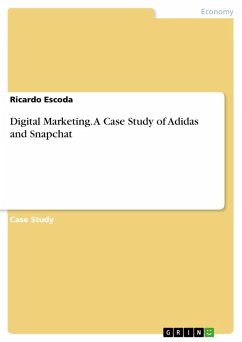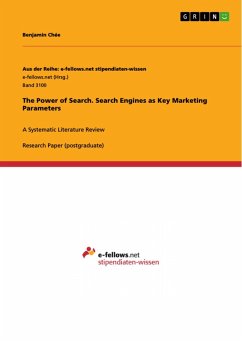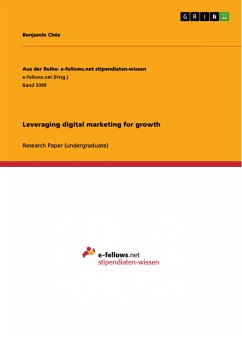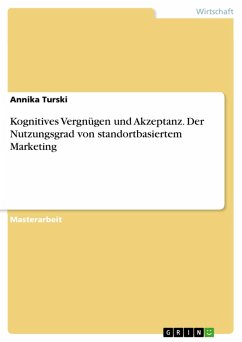
Digital Marketing. A Case Study of Adidas and Snapchat (eBook, PDF)
Sofort per Download lieferbar
Statt: 18,95 €**
16,99 €
inkl. MwSt. und vom Verlag festgesetzt.
**Preis der gedruckten Ausgabe (Broschiertes Buch)
Alle Infos zum eBook verschenkenWeitere Ausgaben:

PAYBACK Punkte
0 °P sammeln!
Case Study from the year 2018 in the subject Business economics - Offline Marketing and Online Marketing, grade: 1,3, International School of Management, Campus Munich, language: English, abstract: Since market power has moved from enterprises to consumers, and global competition has increased substantially, managers in almost all industries need to face enormous performance challenges. To avoid being replaced by rivals, they are forced to be more innovative in establishing and performing their competitive strategies. Long-term success will not be achieved solely through competitiveness but in...
Case Study from the year 2018 in the subject Business economics - Offline Marketing and Online Marketing, grade: 1,3, International School of Management, Campus Munich, language: English, abstract: Since market power has moved from enterprises to consumers, and global competition has increased substantially, managers in almost all industries need to face enormous performance challenges. To avoid being replaced by rivals, they are forced to be more innovative in establishing and performing their competitive strategies. Long-term success will not be achieved solely through competitiveness but instead will depend on the ability to evolve new demand and create and gather new markets. Therefore, marketing is one of the most fundamental topics when concentrating on the customers' desires. Mainly it is about picking up the clients by delivering a unique feeling in form of a must-have product. Adidas is counted among one of the global players of sports and lifestyle brands, together with its biggest competitors Nike and Puma. With an annual revenue of EUR 21.218bn (in 2017), over 56,888 employees worldwide, and more than 900 million products produced per year, the German business is an omnipresent sports and lifestyle brand, which became more and more important over the last decades. According to Statista, it was voted one of the ten most reputable companies worldwide in 2018, being the only sports and lifestyle brand in this ranking. In addition, Forbes published an article, stating that Adidas reached the third place of the World's most valuable sports brands, following Nike and ESPN. Yet by comparing the global revenues of Adidas, Nike and Puma from 2006 to 2017 it can be seen, that the company founded in 1924 by Adi Dassler in a small village in Southern Germany called Herzogenaurach is lagging behind Nike's global revenues for many years. This is one of the core reasons driving the brand with the three stripes to establish new marketing strategies for diversifying and simultaneously increasing its customer portfolio. The sections below concern aspects referring to the research fields E-Marketing and E- Commerce, Online Marketing, Online Advertising and Social Media, and Mobile Marketing. A summary with the most fundamental information is provided at the end of each part.
Dieser Download kann aus rechtlichen Gründen nur mit Rechnungsadresse in A, B, BG, CY, CZ, D, DK, EW, E, FIN, F, GR, HR, H, IRL, I, LT, L, LR, M, NL, PL, P, R, S, SLO, SK ausgeliefert werden.













